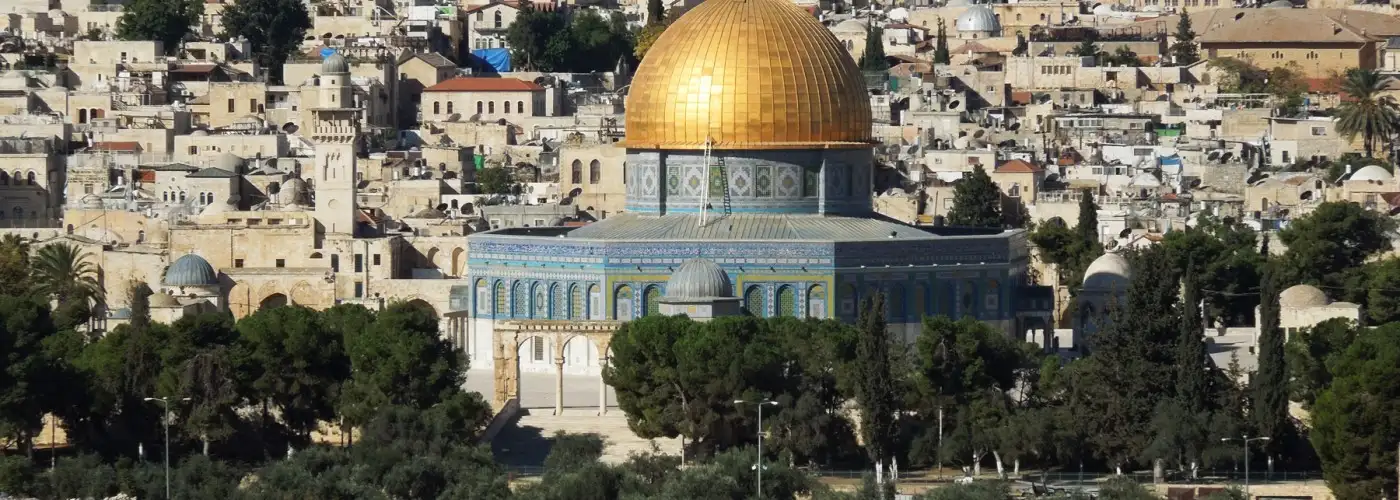Rick Steves has been traveling in Israel and Palestine to film a documentary about these complex and fascinating places. This is the first article in a four-part series about his impressions of the Holy Land.
Before Columbus, many maps of the world showed Jerusalem as the center of the world. Jerusalem—holy, treasured, and long fought over by the three great monotheistic religions—has been destroyed and rebuilt more than a dozen times. Its fabled walls corral a tangle of colorful, holy sites, and more than 30,000 residents—most with a deep-seated reason to live so close to their religious ground zero.
Jerusalem’s tiny historic core, a dense and complex “old town,” is contained within a mighty two-mile-long Ottoman wall. The old city within is divided into four distinct quarters: Armenian, Christian, Jewish, and Muslim. During my visit, I found that the old town is fraught with endless little struggles. For example, the volume of the call to prayer at local mosques is turned up high—some residents think it’s to make a statement and to annoy the Jews. And Jews buy a house in what is historically the Muslim quarter and festoon it with Israeli flags.
But the fascination of Jerusalem isn’t limited to its old town within the walls. Well beyond them lies the ultra-Orthodox Jewish neighborhood of Mea She’arim. Kiosks sell posters of leading rabbis. Each rabbi has his own following, and the rabbi you follow influences how you live and dress. Since this population takes the Shabbat (Saturday) very seriously, Friday is a huge day as all are busy preparing for their holy day of rest.
Some Israelis see these fundamentalist Jews as leaders of their faith. And others see them in less flattering light. One secular local told me, “To these Hassidic Jews, I—with my modern ways—am the enemy. And to me, they are parasites. They don’t work. Our taxes pay for them to just sit around and learn the Torah. Their job is to be religious.” He explained, “They speak Yiddish because they think Hebrew is not for small talk. It’s a holy language.”
The religious scene in Jerusalem is complicated even for tourists. Before planning our day, my guide asked me my religion. Local guides know that, among Christians interested in seeing Jesus’ tomb, most Protestants prefer the burial chamber outside the walls in the Garden Tomb, while Catholics prefer the tomb in the Church of the Holy Sepulcher. While I’m Lutheran, this is one case where I would definitely go with the Catholics.
The Church of the Holy Sepulcher is built upon the summit of Golgotha, where Jesus was crucified. Because it’s holy for all kinds of Christians, who see things differently and don’t communicate very well, it’s a cluttered religious hodgepodge of various zones—each controlled by a different sect. There are chapels for Greek Orthodox, Franciscans, Coptic Christians, Armenians, and so on—each run by a different religious community.
While that church is important, the city’s overall religious focal point is Temple Mount—considered by many to be the closest place on earth to God in heaven. That’s why Jews believe Abraham came here to sacrifice his son, Isaac. The golden Dome of the Rock shrine marks its summit. For Muslims, this rock marks the spot where the Prophet Muhammad journeyed to heaven. It is the third most holy place in Islam. While Muslims have worshipped here since the mid-600s, the first Jewish temple was built in Jerusalem around 925 BCE.
The Western Wall, one of the holiest places on earth for Jews, wasn’t designed to be that way. About 2,000 years ago, it was just the retaining wall that supported the main Jewish temple which stood upon Temple Mount. When the temple was destroyed by the Romans in 70 CE, the Jewish people went into exile. Over the centuries, throughout the diaspora, Jews returning to Jerusalem came here—to all that was left of their temple—to pray and mourn its destruction. That’s why it’s often called the Wailing Wall. The wall is divided into a men’s section and a women’s section. As part of their ritual, Jews place prayers printed on paper into cracks in the wall and stand where they’ve stood since ancient times to pray.
A local Christian told me, “We like to believe that, while God is everywhere, all prayers go through Jerusalem (as if it were a cell-phone tower), and the Holy Spirit comes down to us via Jerusalem.” As he continued, I realized he was spinning a joke. He said, “There’s a golden phone with a direct connection to God at the Vatican. To make a call, it costs $1,000. And there’s a similar golden phone offering the same service here in Jerusalem, where the same call cost only 25 cents.” When I asked why, he said, “It’s a local call.”
Next: A Pilgrimage to the Sea of Galilee.
Rick Steves (www.ricksteves.com) writes European travel guidebooks and hosts travel shows on public television and public radio. Email him at rick@ricksteves.com and follow his blog on Facebook.
(Photo: Rick Steves).
You Might Also Like:
We hand-pick everything we recommend and select items through testing and reviews. Some products are sent to us free of charge with no incentive to offer a favorable review. We offer our unbiased opinions and do not accept compensation to review products. All items are in stock and prices are accurate at the time of publication. If you buy something through our links, we may earn a commission.
Related
Top Fares From Columbus, OH
Today's Top Travel Deals
Brought to you by ShermansTravel
Shop and Save with Country Inns...
Patricia Magaña
 Hotel & Lodging Deals
Hotel & Lodging Deals
$229 -- Chicago: Discounted Rates and...
Francesca Miele
 Hotel & Lodging Deals
$229+
Hotel & Lodging Deals
$229+
$188 -- Honolulu: Save on Oceanview...
Abigail Lamay
 Hotel & Lodging Deals
$188+
Hotel & Lodging Deals
$188+




